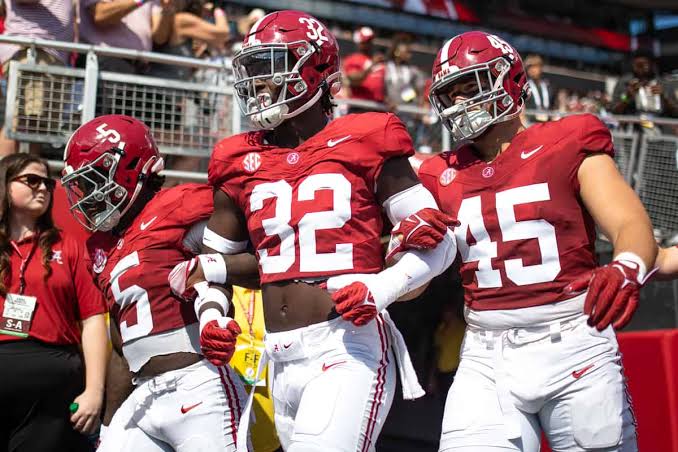
In the world of college football, the Alabama Crimson Tide has long been synonymous with excellence. For over a decade, the program has stood as the gold standard, consistently sitting atop rankings and winning national championships. However, this year, Alabama finds itself ranked No. 11 in the AP Poll—its lowest position in recent memory. This significant drop has sparked a flood of debate, not only about the current state of the program but also about the future of head coach Nick Saban’s dynasty. While Alabama’s ranking may seem like a minor slip, it signifies deeper issues that are difficult to ignore.
A Glimpse of the Past: Alabama’s Reign of Dominance
Under Nick Saban, Alabama football has been nothing short of a dynasty. Since Saban took over as head coach in 2007, the Crimson Tide has won six national championships and produced a steady stream of NFL talent. With this pedigree, a No. 11 ranking might seem like an anomaly, but it’s also reflective of a shift in the college football landscape. Alabama’s dominant days are no longer guaranteed, and this drop in the rankings is the direct result of several factors that cannot be overlooked.
The Death of a Dynasty: Changing College Football
One of the main reasons for Alabama’s dip in the rankings is the changing nature of college football itself. As the sport evolves, the era of dominance by a single team—especially a team from the SEC—is starting to wane. The NIL (Name, Image, and Likeness) era has leveled the playing field in many ways, allowing programs that were once considered “second tier” to now compete for the best recruits. Schools like Georgia, Ohio State, and even Michigan are now more competitive than ever, thanks to the massive influx of financial resources, improved facilities, and coaching staffs with similar pedigree.
Alabama’s traditional recruiting advantages—such as its historic success, its deep pockets, and its ability to secure top-tier talent—are no longer as invincible. While Saban’s recruiting classes are still among the best in the nation, the sheer depth of talent across the country has diluted the Tide’s ability to dominate in the way they once did. And this is where the cracks in the foundation begin to show.
The Quarterback Issue: A Major Roadblock for Alabama
Perhaps the most obvious factor contributing to Alabama’s drop in the rankings is the ongoing struggle at the quarterback position. For years, Alabama has had some of the best quarterbacks in college football, such as Tua Tagovailoa, Jalen Hurts, and Mac Jones, who led the team to national championships and Heisman contention. However, the Tide have yet to find a consistent playmaker at the position since Bryce Young’s departure to the NFL.
Jalen Milroe, the current starting quarterback, has shown flashes of brilliance but has also been inconsistent. His struggles with decision-making, accuracy, and poise in high-pressure situations have been evident in big games, and this is costing Alabama valuable opportunities. Saban’s inability to develop a top-tier quarterback since Young is problematic, and it speaks to a larger issue within the program: a failure to evolve and maintain the elite level of play that once defined the Tide.
Coaching Staff and Adjustments: Saban’s Legacy in Question?
Another factor contributing to Alabama’s drop in the rankings is the increased scrutiny of Nick Saban’s coaching methods. For years, Saban has been praised for his ability to adjust to changes in the game and his willingness to evolve. However, as the sport shifts toward high-powered offenses and dynamic playcalling, Saban’s more traditional, defense-first philosophy seems increasingly out of sync with modern college football trends.
While Alabama’s defense remains formidable, the team’s offensive struggles under offensive coordinator Tommy Rees have been a cause for concern. The Tide’s offense has looked stagnant in certain games, especially when compared to the up-tempo, high-scoring units seen at rival programs like Georgia, Ohio State, and USC. Saban’s insistence on sticking to a “grind-it-out style of play may be limiting Alabama’s overall potential in a game that is increasingly dominated by fast-paced, explosive offenses.
The Recruitment Dilemma: Is Alabama Losing Its Edge?
Alabama’s recruiting has always been the backbone of its success, but even that is starting to show signs of wear. The Crimson Tide have remained in the top five for recruiting rankings year after year, but it’s becoming evident that Alabama no longer has the clear edge it once enjoyed. Other powerhouse programs, particularly in the SEC, are poaching elite recruits, and this has led to Alabama not having the same overwhelming talent advantage over other top programs.
In particular, Georgia, with its ever-expanding recruiting dominance, has surpassed Alabama in terms of securing top-tier talent, especially along the defensive and offensive lines. This gap in recruiting, while not massive, is starting to be reflected in Alabama’s on-field product.
Conclusion: What’s Next for Alabama?
The question now is whether Alabama can bounce back or if the Tide’s time at the top is finally coming to an end. At No. 11, Alabama is still a formidable team, but it’s no longer the invincible force it once was. Nick Saban’s legacy is secure, but as the landscape of college football continues to evolve, Alabama may need to make significant changes to its approach—especially on offense and at quarterback—to keep pace with the competition. Whether or not Saban can navigate this new era and return Alabama to its former glory remains to be seen. What is clear, however, is that the Crimson Tide is no longer the automatic juggernaut it once was, and its ranking at No. 11 is a reflection of that.




